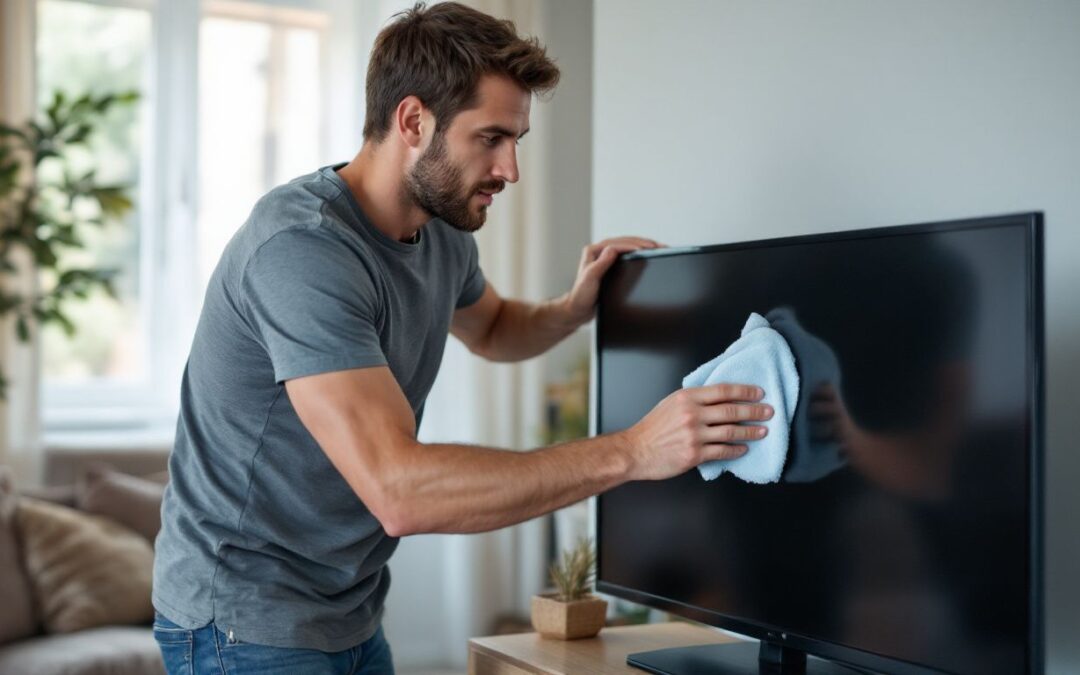Everyone wants a clear view when watching their favorite shows. But dust, fingerprints, and smudges often blur the screen. This is where knowing how to clean TV screen becomes vital.
A fact to note: flat-screen TVs like LED and LCD come with anti-glare coatings that can get damaged if cleaned improperly. The guide below offers easy steps to ensure streak-free cleaning without harming your screen or the special coating on it.
You need to maintain not just a house clean, but also your screens. Get ready for a crystal-clear viewing experience!
Key Takeaways
- Always turn off and unplug the TV before cleaning to prevent electric shock and make dust easier to see.
- Use a dry microfiber cloth for LED, LCD, OLED, and QLED screens to avoid scratches. For tough smudges, slightly dampen the cloth with distilled water instead of using tap water to avoid streaks.
- Create a mild solution of equal parts water and rubbing alcohol for safely cleaning older CRT TVs without damaging the anti-glare coating.
- Keep excessive moisture away from all types of TV screens’ edges to protect internal components from damage.
- Clean remote controls by removing batteries first then wiping them down with a disinfectant or mild cleaning solution to kill germs without causing damage.
Preparing to Clean Your TV Screen
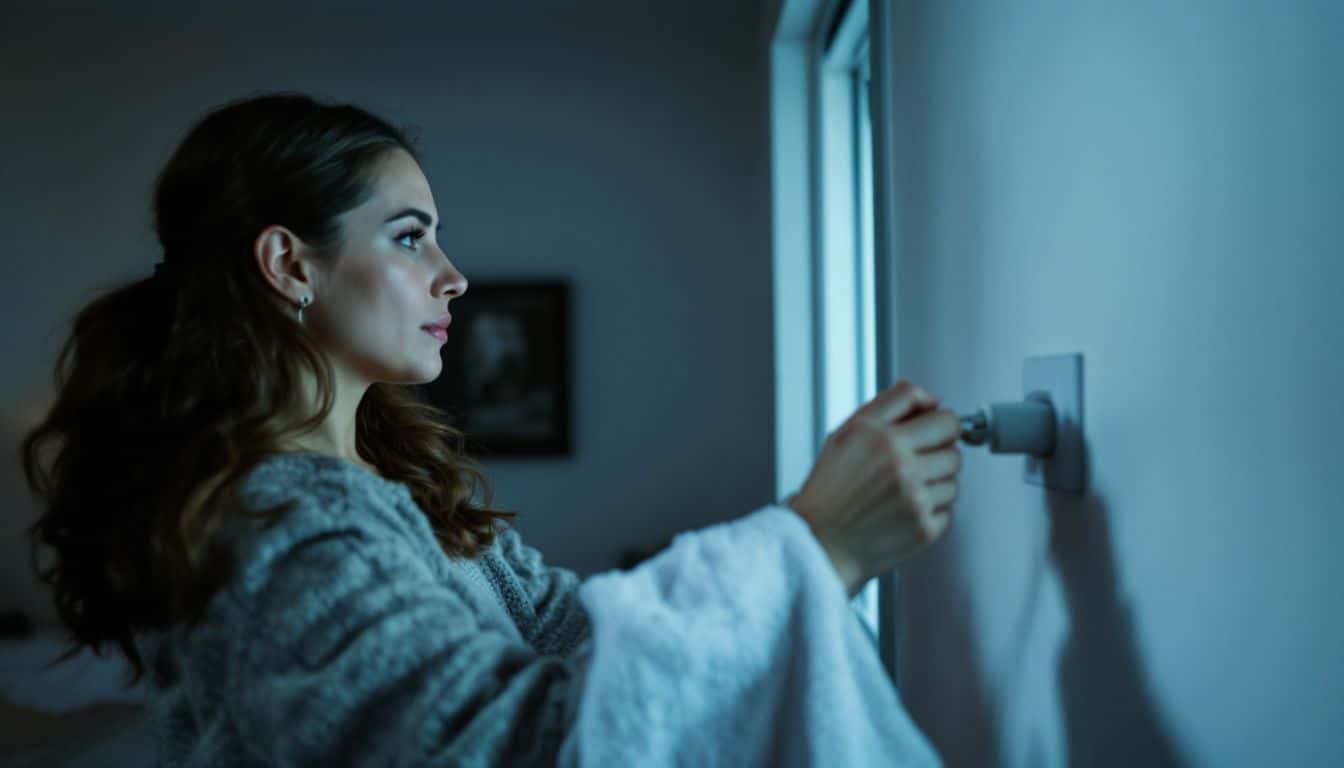
Your content goes here. Edit or remove this text inline or in the module Content settings. You can also style every aspect of this content in the module Design setting
Before you start cleaning your television, make sure to turn it off and unplug it from the wall. Next, find the right tools for the job like a dry lint-free towel and, if needed, some distilled water.
Power down and unplug the TV
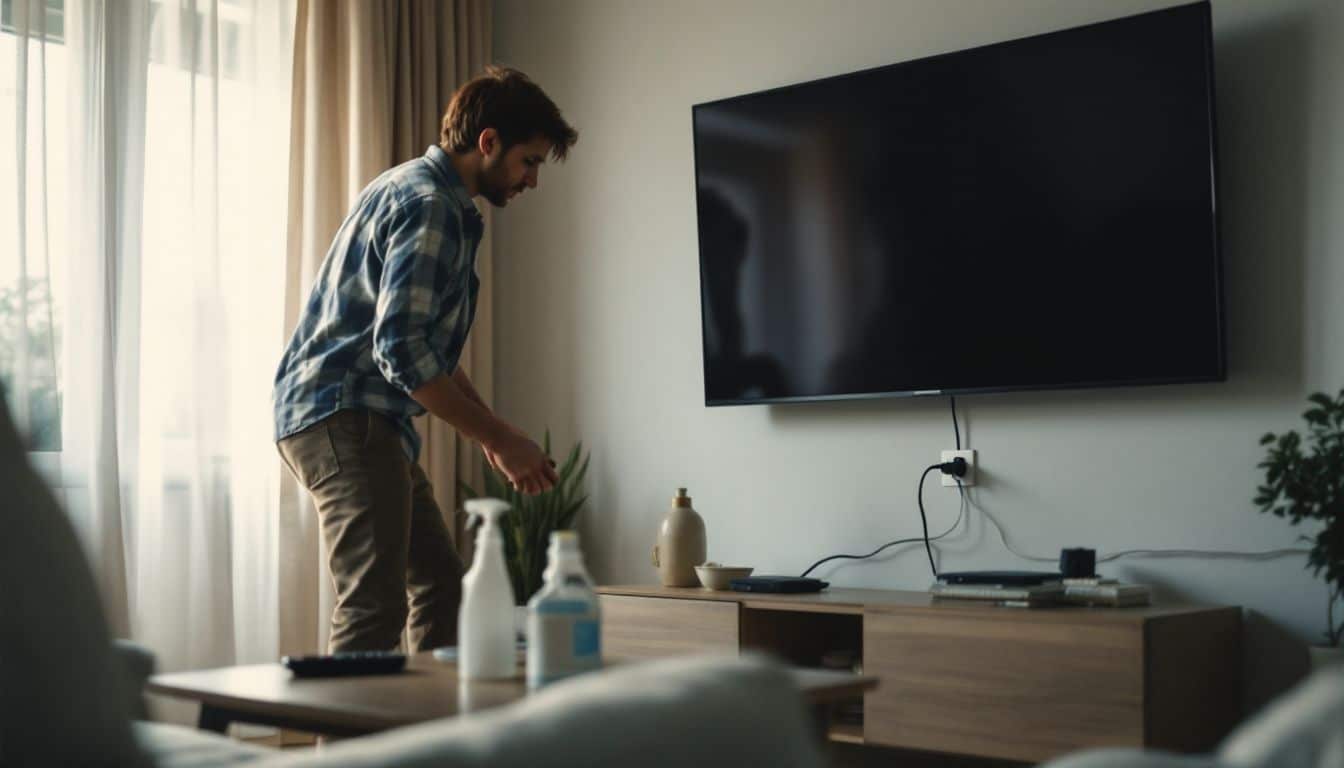
Turning off the TV and pulling its plug out of the socket is a crucial first step before cleaning. This action ensures safety for both the person cleaning and the device itself. It prevents any chance of electric shock and protects the delicate electronics inside from damage during cleaning.
Moreover, having the screen off makes it easier to see dust, fingerprints, and other marks that need removal.
Gathering all necessary items such as microfiber cloths or soft rags next is essential. These tools are gentle on the anti-glare coating found on many modern screens like LED, LCD, OLED, and QLED TVs.
Unlike harsh materials or paper towels, a soft cloth won’t scratch or leave lint behind on your flat-screen TV. Ensuring everything you need is at hand streamlines the process, making it quick and efficient to get back to enjoying a clear picture on your television.
Gather necessary cleaning supplies
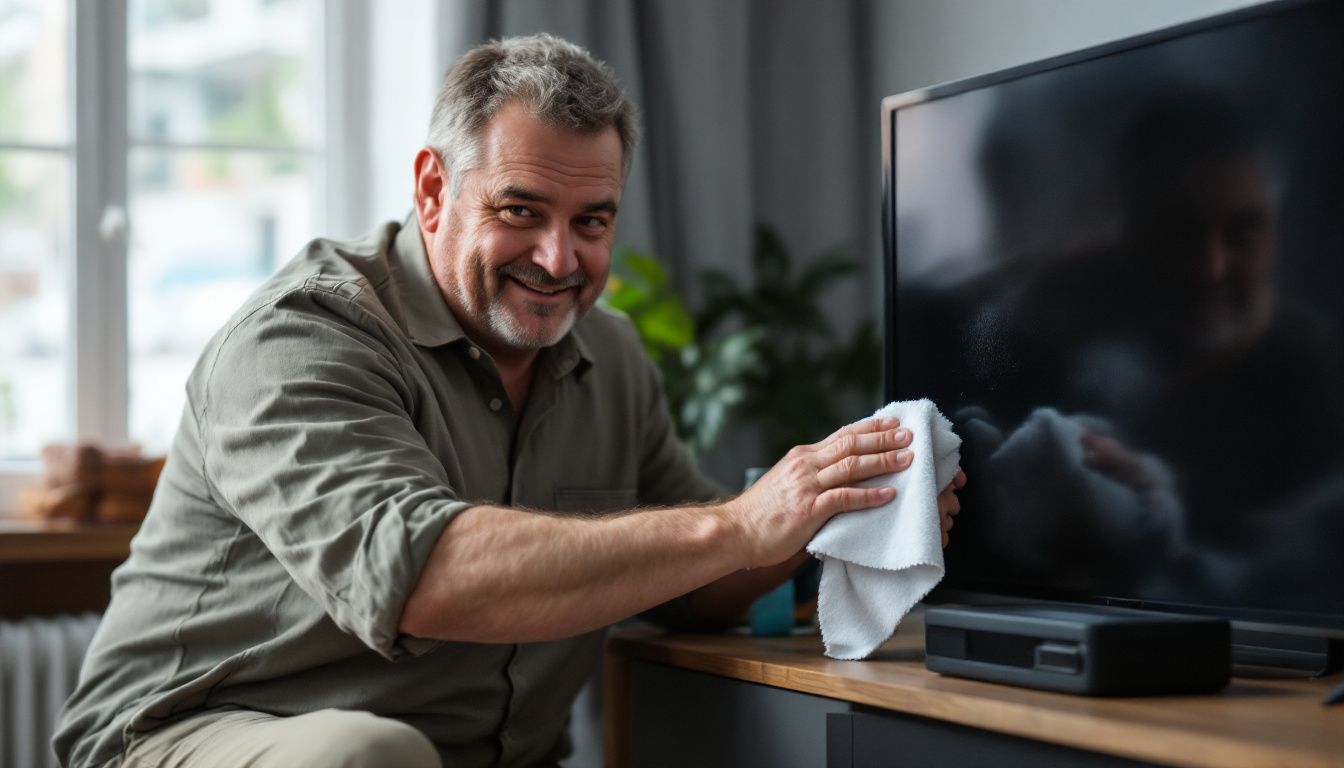
Assembling the appropriate tools before initiating can simplify the task of cleaning your TV screen and ensure safety. For the majority of flat-screen TVs, such as LCD, LED, OLED, and QLED models, a soft eyeglasses cleaning cloth or microfiber cloth is optimum.
These fabrics are gentle and won’t harm the anti-glare coating on your screen. In the scenario of stubborn smudges that resist removal with a dry wipe, distilled water functions as an efficient solvent.
It’s crucial to steer clear of tap water as it may produce streaks from minerals.
For vintage tube TVs or CRT models, professionals suggest a blend of water and rubbing alcohol. This concoction aids in eliminating dust and fingerprints without harming the screen.
Always make sure cloths are damp but not soaked to halt moisture from infiltrating undesired areas of the TV. Lastly, avoid using paper towels or severe chemicals on any screen type as they can be overly abrasive and induce damage.
Cleaning Flat-Screen TVs (LED, LCD, OLED, QLED)
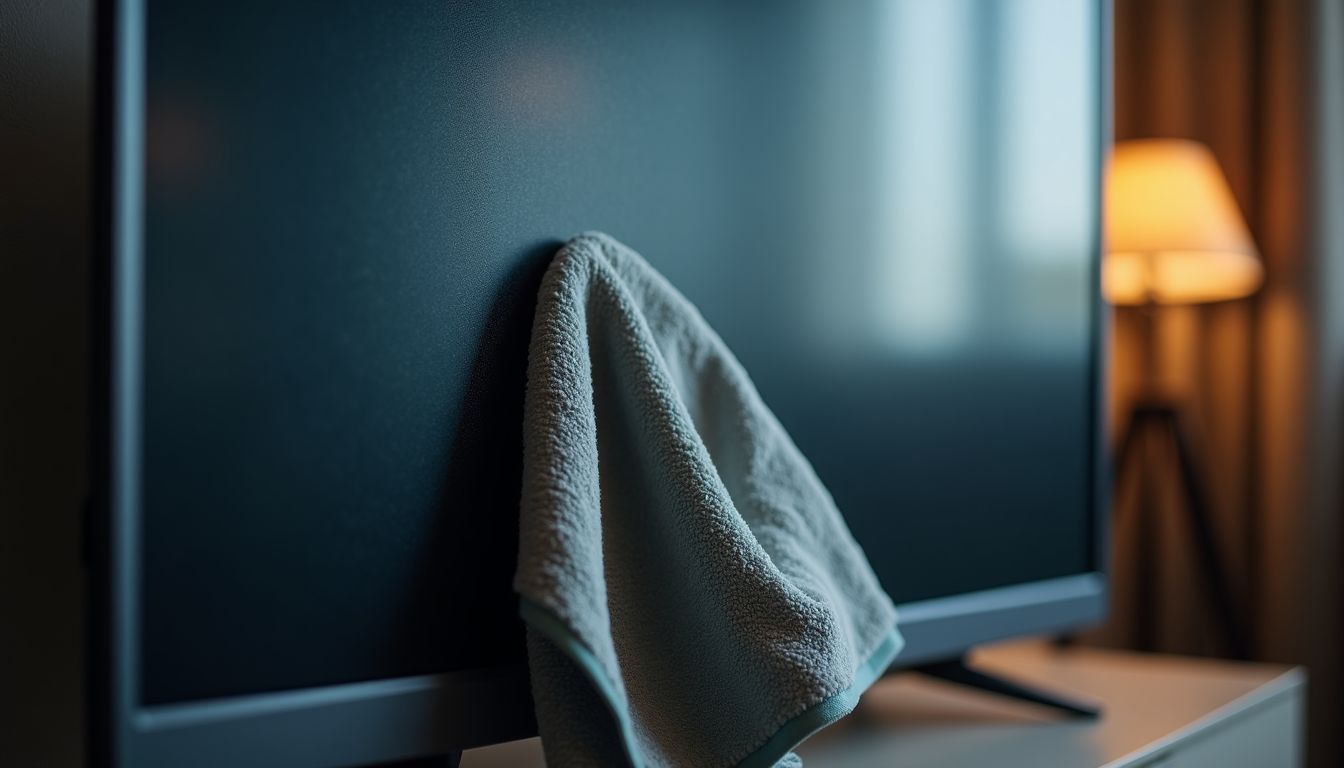
Cleaning flat-screen televisions, whether they are light-emitting diode, liquid crystal display, organic light-emitting diode, or quantum dot light-emitting diode models, requires a gentle touch.
Using a dry microfiber towel is essential for wiping away dust and avoiding scratches on these screens’ delicate surfaces.
Use a dry microfiber cloth
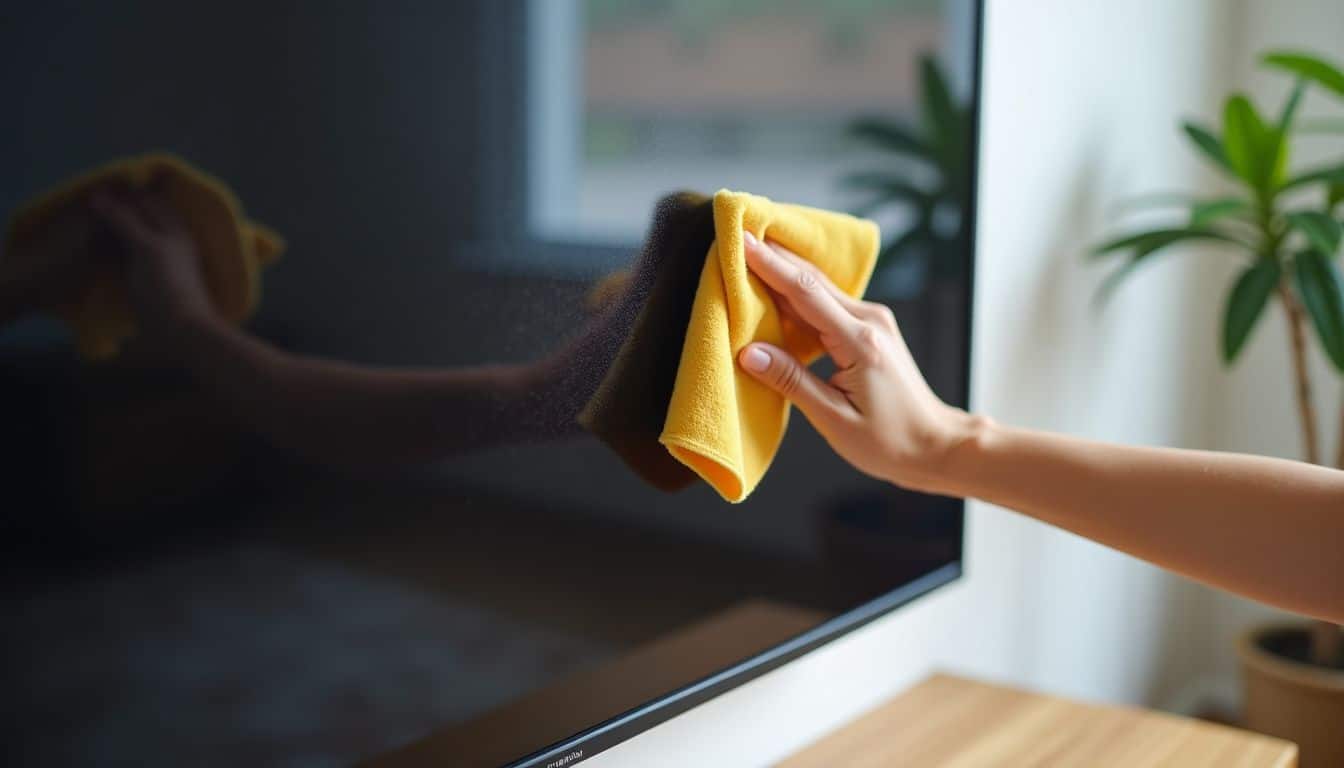
Experts recommend using a dry microfiber cloth to clean flat-screen TVs such as LED, LCD, OLED, and QLED models. This type of cloth is gentle on the screen’s delicate anti-glare coating.
People choose it for its ability to pick up dust and fingerprints without causing streaks or scratches. Start by gently wiping the screen in a circular motion to lift away any dust.
For tougher spots, one might need to slightly dampen part of the cloth with distilled water. Ensure the cloth is not wet but just barely damp to avoid damaging electronics with moisture.
The light moistening helps remove smudges without introducing harmful chemicals that could eat away at the screen surface or strip off protective coatings.
Dampen cloth with distilled water for smudges
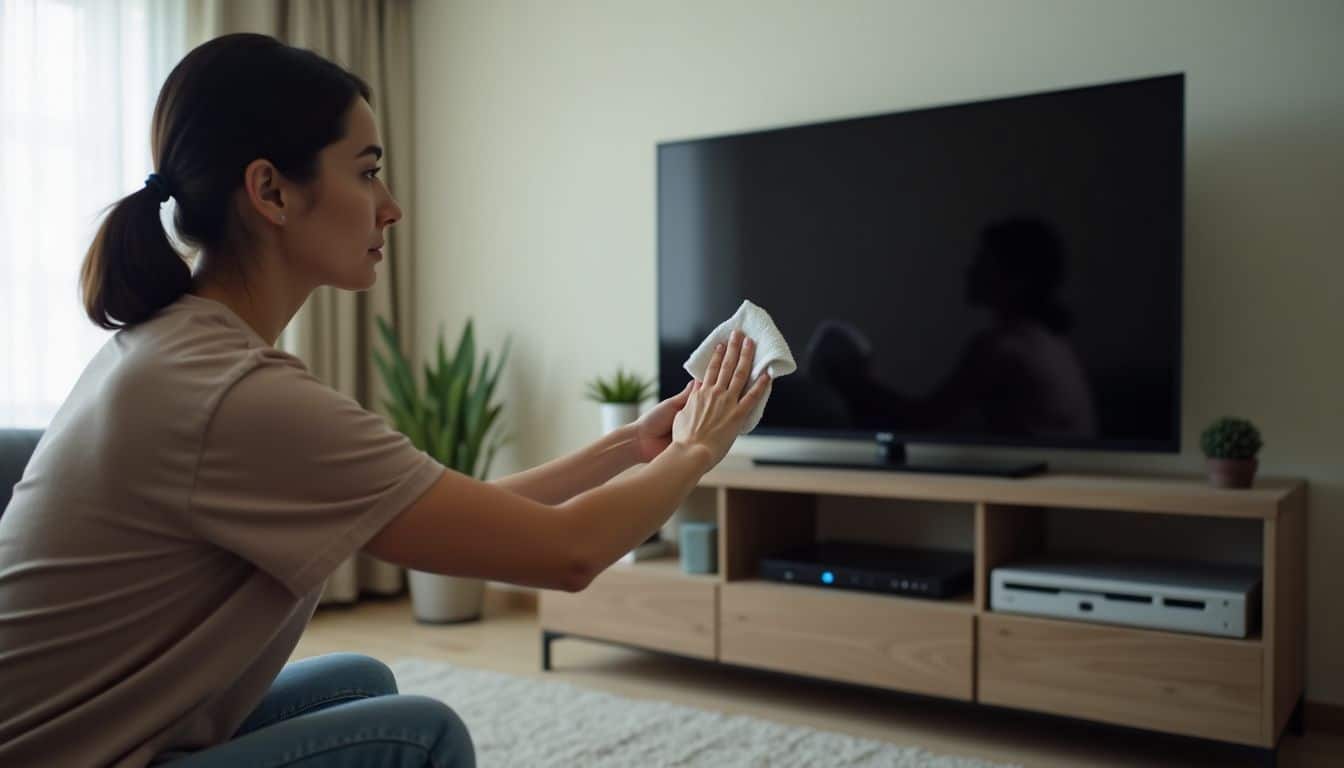
To tackle smudges on flat-screen TVs, such as LED, LCD, OLED, and QLED models, a slightly damp cloth works best. First, soak a soft microfiber cloth in distilled water. Make sure it’s only lightly moistened to avoid any excess water that could harm the screen.
Wiping gently in a circular motion can efficiently remove stubborn spots without damaging the anti-glare coating or leaving streaks behind.
For those harder-to-remove fingerprints and dust particles, this method proves more effective than dry wiping alone. Using distilled water is crucial since tap water often contains minerals that could leave residues or cause harm to the sensitive screen surface.
This simple yet precise technique ensures a streak-free cleaning outcome while preserving the quality of your TV’s display.
Cleaning Older Tube (CRT) TVs
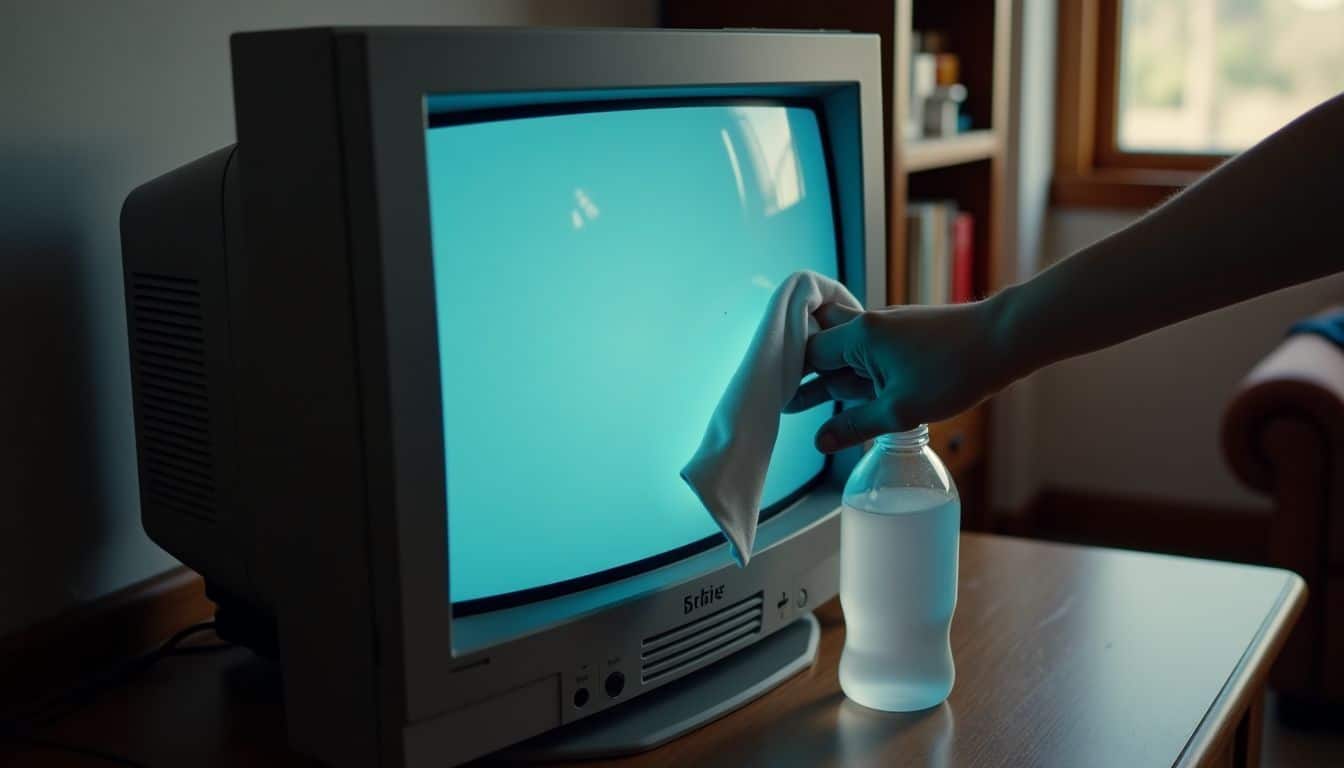
Older cathode ray tube TVs need special care during cleaning. Mix water and isopropyl alcohol in equal parts for a gentle cleanser that won’t harm the screen. Use a soft, lint-free cloth to apply this solution, taking care not to let any liquid drip into the edges of the TV where it might cause damage.
Use a mild solution of water and rubbing alcohol
For cleaning older CRT TVs, mix water with rubbing alcohol to create a gentle cleaner. This mixture is perfect for removing dirt without harming the screen. House owners and parents should apply this solution with a soft cloth.
Make sure the cloth is lightly dampened, not wet.
This method avoids damage to the anti-glare coating found on many cathode ray tube screens. It ensures streak-free cleaning while protecting against dust and fingerprints. Always avoid soaking the cloth too much to prevent excessive moisture near the screen edges, which can lead to damage.
Avoid excessive moisture near the screen edges
After discussing the use of a mild water and rubbing alcohol solution for cleaning, it’s crucial to tackle moisture around the screen edges. Old tube TVs and even modern flat screens have sensitive areas that can’t handle much wetness.
Moisture seeps into these spots easily and might damage the internal components of your TV, leading to costly repairs or a need for replacement.
House owners should exercise caution by not allowing liquid to pool near the screen’s frame. A soft cloth works best for wiping these parts gently. If you’re using distilled water or a mixture with alcohol, make sure it is barely damp.
This practice ensures your device stays safe while removing dust and fingerprints efficiently without risking harm to its intricate workings or anti-glare coating.
Don’t Forget the Remote Control
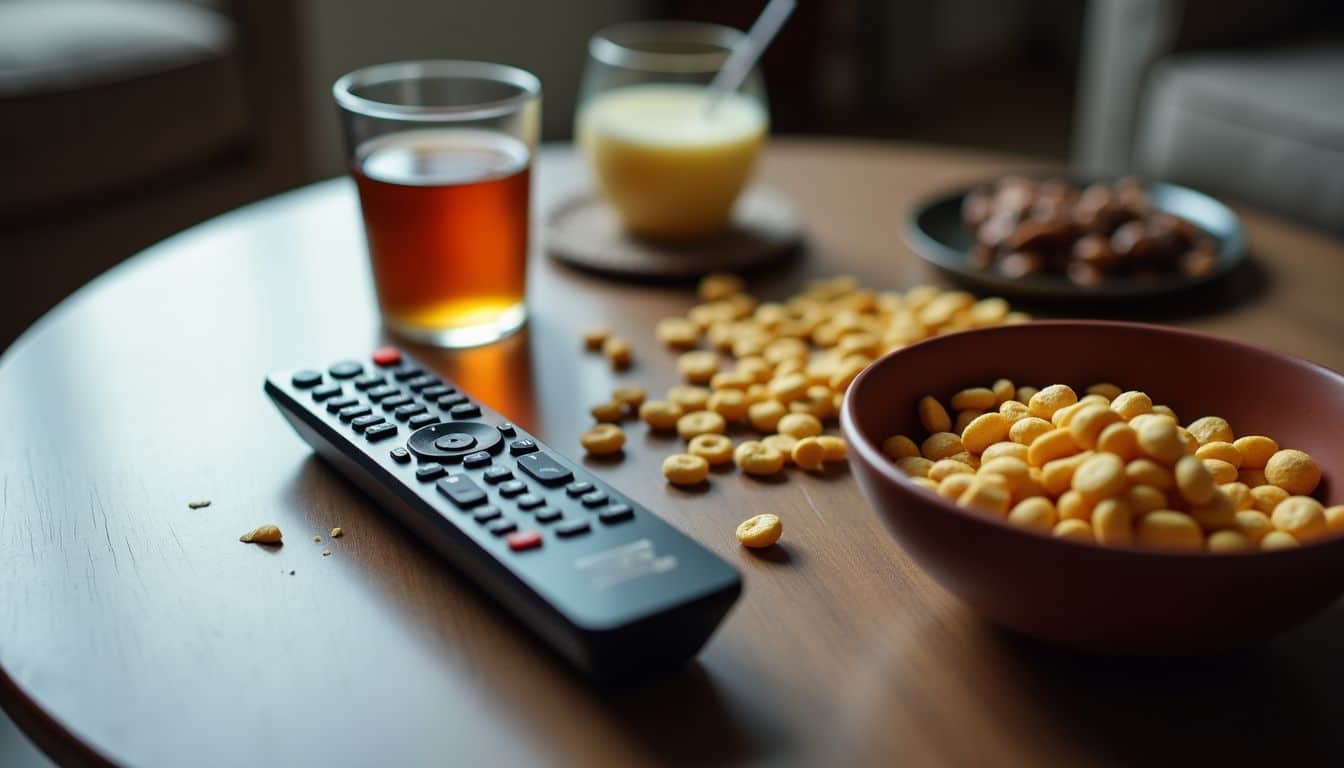
The TV’s best friend, the remote control, also needs a good cleaning. Before starting, take out its batteries and use a germ-killing solution or gentle cleaner on it.
Remove batteries before cleaning
Before cleaning a remote control, taking out the batteries is crucial. This step prevents any risk of electrical shorts or damage to the battery compartment. It ensures that moisture doesn’t get into the electronics, which could lead to malfunctioning buttons or a completely unresponsive controller.
After removing the batteries, it’s safe to wipe down the remote with a mild cleanser or disinfectant solution. Using a soft cloth lightly dampened with this solution helps kill germs without harming the remote’s surface.
For sticky spots, gently scrubbing with an eyeglasses cleaning cloth can remove grime without scratching the plastic.
Wipe with a disinfectant or mild cleaning solution
After detaching the batteries, ensuring the cleanliness of the remote control serves as a vital task towards maintaining sanitation. Experts advocate for a thorough wipe using a low-intensity cleanser or sterilizer.
This process aids in keeping the remote free from bacteria, concurrently avoiding harm to its delicate components. A basic blend of water and isopropyl alcohol proves to be a suitable means for this end.
The user is encouraged to tenderly apply the solution with a soft cloth, making certain the device doesn’t become saturated.
For regular cleaning, utilizing a dry cloth effectively removes both dust and unattractive smudges from the surface of the remote. In instances of stubborn spots or more difficult dirt, a gentle dab of a diluted cleaning solution on a cloth provides a powerful solution without harming the non-reflective coating or buttons.
Both homeowners and parents deem these approaches as harmless and ideal for the electronics within their homes, promoting a clean environment without presenting a threat to any devices.
Conclusion
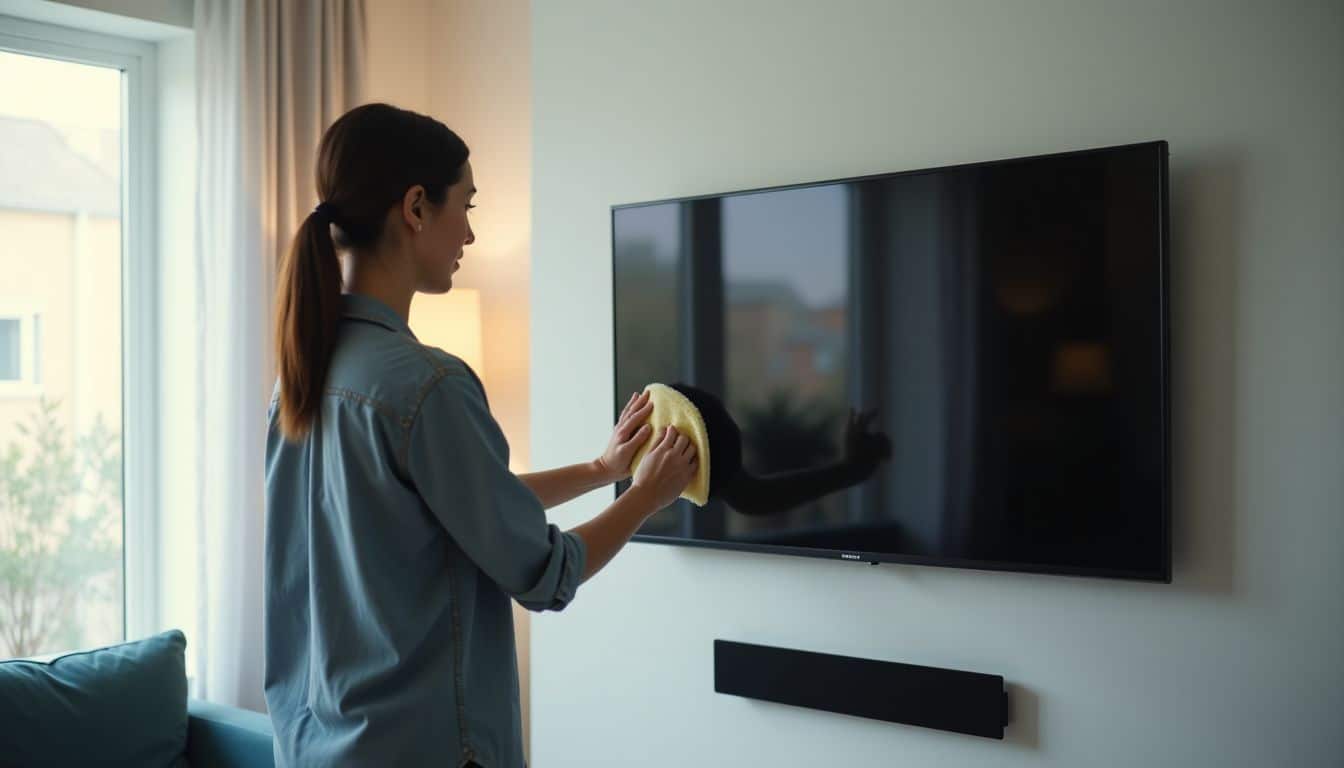
Cleaning your TV screen doesn’t have to be hard. With the right tools, like a microfiber cloth and distilled water, anyone can do it. For flat-screen TVs such as LED or LCD, stick to a dry cloth.
If you need more cleaning power, use distilled water lightly. For older models like CRT TVs, mix water with rubbing alcohol for safe cleaning. Don’t forget the remote control; clean it without batteries using a gentle solution.
This way ensures both clear viewing and safe hygiene around your home entertainment area. Follow these steps for an easy and effective way to keep your screens looking their best.
Book cleaning services online now, it’s easy, fast and you get a price right away.
FAQs
1. What is the best method to clean my TV screen?
The best way to clean your TV screen, whether it’s an LCD, LED, OLED, plasma or CRT TV, involves using a microfiber cloth or eyeglasses cleaning cloth for streak-free cleaning. Avoid harsh chemicals that could damage the anti-glare coating.
2. Can I use paper towels and water for my flatscreen TV?
Paper towels are not recommended as they may scratch the delicate surface of your flatscreen TV. Instead, use a soft dry cloth and distilled water if necessary to remove dust and fingerprints.
3. How often should I clean my TV screen?
The frequency of tv screen cleaning depends on how quickly dust accumulates or fingerprints appear on your screen. Regular gentle cleaning will maintain optimal viewing quality.
4. Are there any specific tips from trusted sources like Good Housekeeping or HGTV.com about tv screen cleaning?
Both Good Housekeeping Institute and HGTV.com recommend avoiding harsh chemicals when cleaning your television screens; instead suggesting soft cloths and minimal moisture for effective results.
5. Can I use commercial cleaners on my television screens?
Commercial cleaners with harsh chemicals can potentially harm the anti-glare coating found on many modern TVs including LCDs, LEDs & OLEDs; hence their usage is generally discouraged in favor of softer alternatives.

